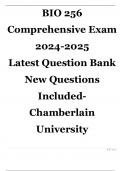BIO 256
Comprehensive Exam
2024-2025
Latest Question Bank
New Questions
Included-
Chamberlain
University
1|Page
,BIOS 256 Final Exam
1 The urinary system does all of the following, EXCEPT it
A secretes excess glucose molecules
B regulates blood volume
C contributes to stabilizing blood pH
D eliminates organic waste products
E regulates plasma concentrations of electrolytes
2 Conical structures that are located in the renal medulla are called
A pyramids
B renal columns
C renal pelvises
D nephrons
E calyces
3 The region known as the macula densa is part of
A the proximal convoluted tubule
B the distal convoluted tubule
C the collecting duct
D the ascending loop of Henle
E Bowman’s capsule
4 The cells of the macula densa and the juxtaglomerular cells form the
A renal corpuscle
B filtration membrane
C loop of Henle
D juxtaglomerular apparatus
2|Page
, E afferent arteriole
5 A glomerulus is
A the expanded end of a nephron
B a knot of capillaries that lies within the renal corpuscle
C the portion of the nephron closest to the renal corpuscle
D the portion of the nephron that attaches to the collecting duct
E the horseshoe-shaped segment of the nephron
6 The following is a list of the blood vessels that carry blood to the kidney.
1. afferent arteriole
2. arcuate artery
3. interlobar artery
4. renal artery
5. glomerulus
6. interlobular artery
7. efferent arteriole
8. peritubular capillary
The proper order in which blood passes through these vessels is
A 4, 6, 2, 3, 1, 5, 7, 8
B 4, 3, 2, 6, 1, 5, 7, 8
C 4, 3, 2, 6, 7, 5, 1, 8
D 4, 6, 2, 3, 7, 5, 1, 8
E 4, 3, 6, 2, 1, 5, 7, 8
3|Page
, 7 The process of filtration is driven by
A active transport
B blood osmotic pressure
C blood hydrostatic pressure
D renal pumping
8 The mechanisms for maintaining the solute concentration gradient in the renal medulla
require
A active transport of sodium and chloride ions from the ascending limb of
the loop of Henle
B active transport of sodium and chloride ions from the ascending limb of the vasa recta
C the ascending limb of the loop of Henle to be permeable to water
D the vasa recta to be impermeable to water
E both A and B
9 Which of the following is greater?
A the concentration of solute in the filtrate at the beginning of the loop of Henle
B the concentration of solute in the filtrate at the bottom of the descending
limb of the loop of Henle
10 The antidiuretic hormone
A increases the permeability of the collecting ducts to water
B is secreted in response to low concentrations of potassium ions in the extracellular
fluid.
C causes the kidneys to produce a larger volume of relatively solute-free urine
D helps regulate the concentration of potasium ion in the interstitial space
E is sensitive to changes in the blood concentrations of both sodium and potassium
11 In the loop of Henle
A water is secreted into the descending limb
B sodium and chloride ions are actively transported out of the ascending
limb
C the ascending limb is very permeable to water
4|Page




